The 36 Inch Antique Bathroom Vanity: A Comprehensive Guide
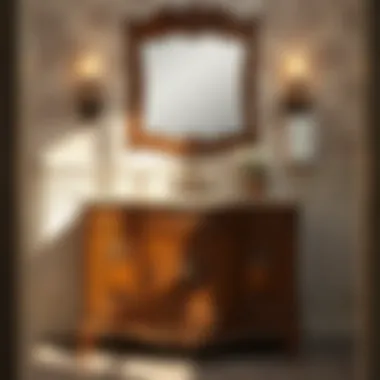
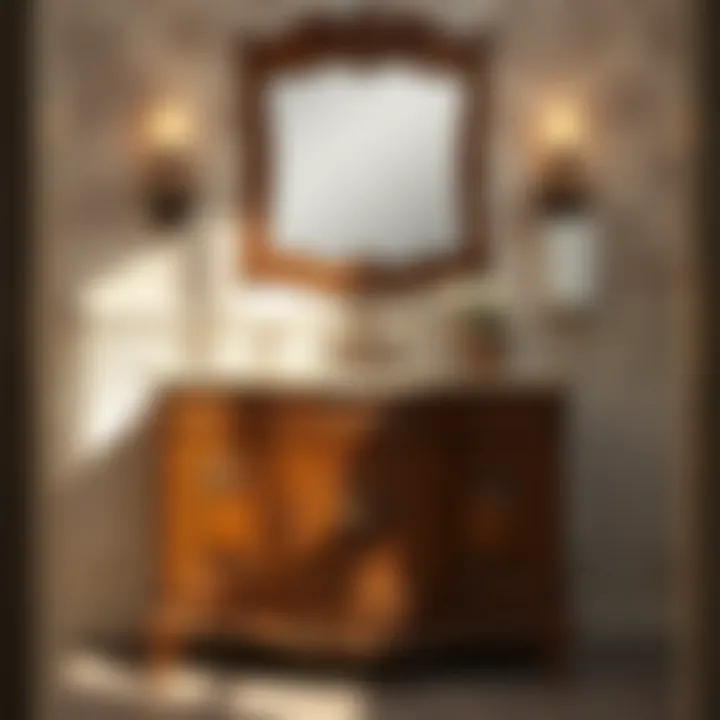
Intro
In the realm of home design, finding the perfect balance between functionality and aesthetics can be a daunting task. The 36-inch antique bathroom vanity serves as an excellent focal point in any bathroom, combining classic charm with practicality. These vanities offer not only ample storage and utility but also a style that evokes nostalgia while complementing modern decor trends.
In this guide, we dive deep into the allure of the antique bathroom vanity. We'll explore various trending styles, the latest color palettes, common materials, and practical tips on how to select and maintain your vanity. By the end, you will be equipped with valuable insights on how to craft a bath oasis that is both beautiful and organized.
Trending Styles
Modern Minimalism
Minimalism has captured hearts and homes alike, focusing on simplicity and clean lines. However, incorporating a 36-inch antique vanity into this design can strike a delicate balance. A beautifully restored wooden vanity with sleek hardware can stand out without overwhelming the space. The beauty of this style lies in the understated elegance of the antique, which complements the uncluttered atmosphere of a modern minimalist bathroom.
Picture this: a light oak antique vanity with a smooth white countertop nestled against pale walls and a large mirror. The contrasts create an inviting yet serene environment that encourages relaxation and rejuvenation.
Cozy Rustic
On the other hand, the cozy rustic theme draws from nature, emphasizing warmth and comfort. A 36-inch vanity with distressed wood, wrought iron accents, or vintage finishes blends seamlessly into a rustic bathroom. The idea is to evoke a sense of tranquility often associated with countryside living. Imagine a dark-stained, reclaimed wood vanity adorned with vintage decor items, such as ceramic jars and handmade soap dishes, all contributing to a charming and inviting space.
Color Palettes
Calming Neutrals
Soft hues like beige, cream, and soft grey set a calming backdrop, allowing the antique vanity to shine. These tones are timeless and versatile, accommodating a range of decorations and accessories. For instance, pairing a warm beige antique vanity with soft grey walls creates a soothing ambiance, making it an ideal retreat after a long day.
Bold Accents
Sometimes, playing with color can bring life to your space. Bold accent colors, such as deep blues or fiery reds, can enliven the bathroom environment, especially when incorporated around a vintage vanity. A vibrant turquoise wall with a classic mahogany 36-inch vanity could offer a striking contrast, showcasing both the richness of color and the intricacies of antique craftsmanship.
Remember: when picking color palettes, always consider the overall vibe you wish to establish. Harmonious colors can enhance the beauty of your antiques, making them feel even more integrated into your space.
In essence, understanding the trending styles and carefully choosing color palettes enables one to create an exquisite bathroom environment centered around the 36-inch antique bathroom vanity. Whether one leans towards sleek modernity or warms up to rustic charm, these vanities stand as versatile pieces tailored to elevate the overall aesthetic of today’s homes.
Foreword to Antique Bathroom Vanities
Antique bathroom vanities carry a unique charm that adds a touch of elegance to any bath space. They serve not merely as a functional element but as a statement piece that embodies history and craftsmanship. One specific category that has captured the attention of homeowners is the 36-inch antique bathroom vanity. This size strikes a sweet spot between spaciousness and compactness, making it suitable for various bathroom layouts.
When incorporating an antique vanity into modern design, it’s crucial to consider how style, functionality, and space interconnect. A 36-inch vanity not only offers ample storage but also acts as a focal point, tying together aesthetics and practicality.
The right antique vanity can elevate a mundane bathroom into an oasis of relaxation and style. It reveals a story—each scratch and smudge tells a tale, whisking you back to a different time. Furthermore, opting for a piece that reflects your personal taste can enhance your home's overall ambiance, thereby creating a harmonious living environment.
Defining the Antique Bathroom Vanity
An antique bathroom vanity is defined not just by its age but by the craftsmanship that often accompanies handmade pieces of the past. Generally, these vanities are classified as being over 100 years old, showcasing premium materials and intricate designs. They come in various forms, from rustic wooden structures to ornate, carved designs that capture the essence of different stylistic periods.
Key characteristics of antique vanities include:
- Hand-carved wood
- Period-specific hardware
- Unique finishes that show patina
- Solid construction that stands the test of time
Findings show that many homeowners appreciate the character and uniqueness that antique pieces bring, setting them apart from standard, mass-produced fixtures.
Historical Context and Evolution
Understanding the evolution of the antique bathroom vanity requires a dive into the progression of bathroom designs throughout history. In the early 19th century, the concept of the bathroom itself was evolving. The vanity, as we know it today, began to take shape in European households, particularly with the rise of the middle class.
During this period, practicality and aesthetics started to intertwine, leading to the first designs that incorporated elements of style. Materials used often reflected local resources; for example, East Coast homes frequently featured mahogany, whereas walnut was more common in the Midwest.
By the time the Victorian era rolled around, intricacy became the norm. Vanities were adorned with elaborate carvings and ornate mirrors. The shift from necessity to luxury defined this period, as people began to see the importance of the vanity in not just utility, but in self-presentation as well.
As the years marched on, various design movements influenced bathroom aesthetics, from Art Deco to Mid-Century Modern. However, the enduring appeal of antique bathroom vanities lies in their ability to blend with modern functionality while retaining historical significance.
"Every scratch and patina on an antique piece tells a story, echoing the lives once lived around it."
The rich history and evolving aesthetics of antique bathroom vanities ultimately make them timeless choices for homeowners looking to create a distinctive and personal bathroom space.
Why Choose a Inch Vanity
When considering a bathroom renovation or simply refreshing a space, the 36-inch antique bathroom vanity often emerges as a stellar choice. This size strikes a remarkable balance, offering ample storage without overwhelming the room. Embracing this size introduces an aesthetic harmony while tackling functionality concerns that modern homeowners are increasingly considering.
Balanced Proportions in Bathroom Design
In interior design, balance is everything. The 36-inch vanity sits snugly between the compact models and larger, bulkier counterparts. It serves as a midpoint that adapts well to a variety of bathroom dimensions, enhancing visual appeal regardless of the overall space. This often results in a more cohesive look and feel.
Using a vanity of this size, you can complement the surrounding elements—such as mirrors and lighting fixtures—while ensuring that the space does not feel cramped or overly spacious. A well-placed 36-inch vanity can act as a defining feature, creating a focal point that pulls the entire room together. Not to forget, it provides enough surface area for necessary toiletries without sacrificing style, making it functional and pleasing to the eye.
Space Considerations
Space often dictates the choices we make when it comes to bathroom fixtures. In this context, the 36-inch vanity offers versatility that can’t be overlooked. Whether you are navigating a powder room or a family bathroom, it finds a way to fit seamlessly.
Here’s a few reasons why space considerations play a vital role:
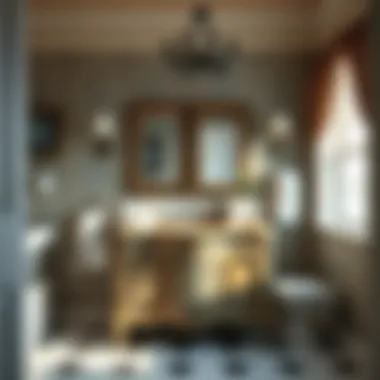
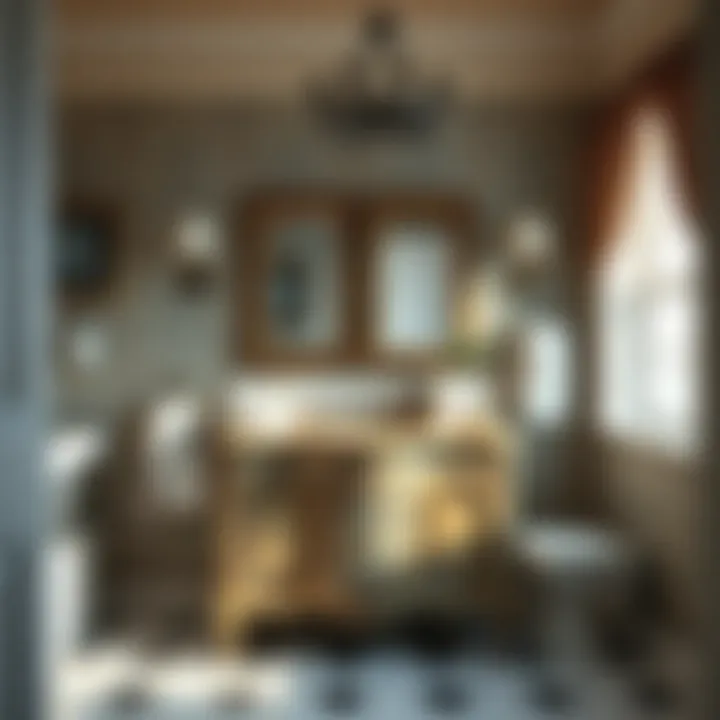
- Storage Compromise: The right-sized vanity can provide adequate storage for towels, cleaning supplies, and personal items while avoiding the clutter that larger vanities often bring.
- Movement and Flow: It’s crucial that pathways within bathrooms remain unobstructed. A 36-inch vanity facilitates movement and ensures that occupants can easily navigate the space. Imagine stepping out of the shower, only to be greeted by a wall of cabinetry—it feels cramped! Instead, the right size can open up possibilities.
- Style and Resale Value: When buyers look at homes, potential resale value makes an impact. Vintage-inspired designs, particularly in the 36-inch range, resonate well with buyers who appreciate classic over contemporary. Plus, they tend to age gracefully, appealing to a broad market.
In summary, choosing a 36-inch antique bathroom vanity is not merely about style; it reflects a thoughtful balance of proportions and practical considerations tailored to meet the needs of both today and tomorrow. This size thoughtfully marries design with function, enhancing the overall ambiance and utility of your bathroom.
Design Styles for Inch Antique Vanities
Choosing the right design style for a 36-inch antique bathroom vanity is more than just aesthetics; it’s about ensuring that the piece blends seamlessly with your overall bathroom scheme. This section delves into the various design styles available, highlighting their specific elements, benefits, and the particular charm each brings to a bathroom space. Whether you’re looking for something classic or a bit more contemporary, understanding these styles can help you make an informed decision that resonates with your personal taste and the ambiance of your home.
Traditional Design Elements
When one thinks of traditional design elements in antique vanities, images of rich woods and ornate detailing often come to mind. Traditional vanities are characterized by their craftsmanship—cabinet doors with intricate carvings, raised panel designs, and oftentimes, a warm color palette.
The materials used, typically hardwoods such as oak, cherry, or mahogany, exude both durability and luxury. Moldings and trims—often leaf or floral motifs—enhance the overall classic vibe.
Consider the elegance that a piece like this can add:
- Timeless Appeal: These styles never go out of fashion. Investing in a traditional vanity is like buying a piece of history that forever retains its value.
- Versatility in Decor: They work beautifully with vintage tiles and classic fixtures, allowing for a cohesive design without forcing a modern twist.
An exquisite example might be a vanity with a dark walnut finish, paired with a marble countertop. This combination evokes a sense of luxury and comfort, creating a serene atmosphere to unwind after a long day.
Transitional Styles
Transitional styles serve as a bridge—merging the old with the new. This design approach is ideal for individuals looking for a harmonious mix that doesn’t lean too far into either traditional or modern territory.
Characteristics of transitional vanities include simplicity in design while still maintaining some traditional elements. Common features are:
- Straight Lines with Soft Curves: The silhouettes often feature clean lines, but maintain soft edges that add a touch of warmth.
- Neutral Color Palettes: Whites, grays, and beiges dominate, allowing for easy integration into various color schemes.
Opting for a transitional vanity may come with advantages such as:
- Flexibility: They seamlessly fit into various bathroom styles and can easily adapt to changing decor.
- Modern Functionality: Many transitional designs incorporate modern conveniences, such as soft-close drawers or built-in organization, adding practicality to beauty.
Modern Interpretations
While antique vanities are rooted in historical design, modern interpretations push the envelope of creativity and function. A modern antique vanity might feature unexpected elements such as sleek lines and minimalist designs while still drawing inspiration from the past.
Here’s what to look for:
- Unexpected Materials: Think concrete or tempered glass paired with wood. The mix can create a unique focal point.
- Sleek Hardware: Instead of ornate handles, you may find metal accents in brushed nickel or matte finishes that provide a contemporary touch.
Advantages of choosing a modern interpretation can include:
- Unique Statement Pieces: They can become conversation starters in a bathroom setting.
- Functionality Meets Style: Many modern designs prioritize storage solutions, ensuring that beauty does not come at the expense of practicality.
In closing, each of these styles showcases how diverse a 36-inch antique bathroom vanity can be. From the warmth of traditional craftsmanship to the edgy flair of modern designs, these vanities can significantly influence the aesthetic and functionality of your bathroom. Choose wisely, and you’ll find a piece that not only fits your space but also tells a story.
Materials and Finishes
When it comes to incorporating a 36 inch antique bathroom vanity into your home, understanding the materials and finishes is vital. These elements not only shape the aesthetic appeal but also influence durability and maintenance. Selecting the right combination can enhance the overall charm of your bathroom while ensuring practicality that meets everyday needs.
Wood Types and Their Characteristics
Wood is often the star of an antique bathroom vanity. The choice of wood can dictate the style, character, and longevity of the piece. Here are some prominent wood types commonly used:
- Mahogany: Known for its rich color and durability, mahogany is a classic option that exudes elegance. Its fine grain gives it a distinctive appearance, making it a favorite for those seeking luxurious finishes.
- Oak: With its robust texture and prominent grain, oak is not only strong but also lends a rustic feel to the vanity. It’s resistant to wear, ensuring it stays beautiful for years.
- Pine: This is a lighter wood, easy to work with, and often more affordable. While it may not carry the same weight as hardwoods, it can be treated to enhance its aesthetic quality.
- Cherry: Characterized by its warm tones, cherry wood deepens in color over time. This adaptability makes it a sought-after choice for antique styles.
Understanding these wood options can guide your decision and set the groundwork for a vanity that speaks to your personal style while fitting into your bathroom's design.
Metal Accents and Hardware
The finishing touches of a vanity can truly elevate its presence, and that’s where metal accents and hardware come into play. Knobs, handles, and hinges, when chosen carefully, can either integrate seamlessly or provide a striking contrast to the woodwork.
- Brass: Often associated with vintage and antique themes, brass hardware can enhance the nostalgic feel of a vanity. Over time, it develops a patina that adds character.
- Chrome: For those leaning towards a more modern twist on antique design, chrome hardware can provide a fresh look while still preserving the classic essence.
- Black Iron: This is an excellent choice for adding an industrial touch, creating a juxtaposition between the warmth of the wood and the rawness of the metal.
When selecting hardware, think about how the metal elements will play against the wood finishes. The right choice can tie the whole look together and enhance the antique allure.
Surface Finishes and Their Maintenance
Surface finishes are critical in preserving the appearance and longevity of your vanity. Different finishes provide varying levels of protection while affecting the visual output:
- Lacquer: This creates a hard finish that is easy to maintain but can damage if harsh chemicals are used for cleaning.
- Oil: An oil finish penetrates the wood, enhancing its natural beauty and providing a soft sheen. However, it may require more frequent application than other finishes.
- Varnish: This is another common finish offering a durable layer of protection. It's mostly waterproof and resistant to stains, making it a practical option in a bathroom setting.
- Wax: Less common in modern vanities, wax can offer a subtle luster but will need regular reapplication.
For maintaining the surface, gentle cleaning solutions and regular upkeep are key. Avoiding harsh abrasives will prevent scratches and extend the lifespan of the vanity.
Choosing the right materials and finishes for your antique bathroom vanity is crucial. It’s not just about the look; it’s about making a choice that complements your living space while ensuring functionality and ease of care.
In summary, materials and finishes are foundational topics when discussing a 36 inch antique bathroom vanity. From wood types suitable for the overall design aesthetic to the hardware that lends character, and to the finishing touches that enable longevity—each aspect plays a pivotal role in crafting a masterpiece right in your bathroom.
Customization Options
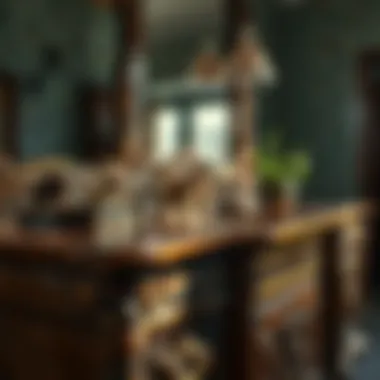
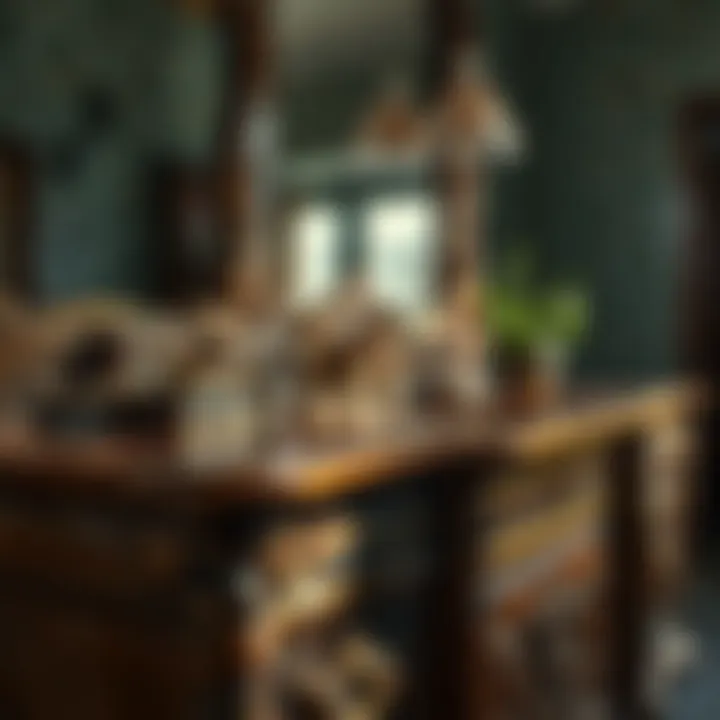
When it comes to creating a space that reflects personal style, customization options for a 36-inch antique bathroom vanity play a pivotal role. Not only do these options enhance the overall aesthetic of a bathroom, but they also cater to the unique needs and preferences of homeowners. Understanding the various ways in which these vanities can be tailored offers significant benefits, enabling you to blend functionality with style seamlessly.
Modifying Dimensions and Features
Modifying dimensions and features of a vanity can dramatically change its impact in a bathroom. Whether you're looking for a more compact piece that fits against a wall or a grand centerpiece for your space, adjustments in size can be made to meet your needs. For instance, if the vanity feels cramped in its environment, a wider countertop could provide more functional space for toiletries and decorative items. Additionally, understanding your plumbing layout is essential to ensure that modifications align with necessary installations.
Another aspect of customization involves the features that accompany the vanity. Traditional vanities may come with basic pedestal sinks or single drawers, but integrating double sinks or additional storage options can cater to more extensive family needs or personal preferences. Thoughtful consideration in this area not only enhances convenience but also adds a touch of personalized luxury.
Personal Touches and Accessories
Adding personal touches to your antique vanity is where the magic truly happens. Accessories can elevate the functionality and aesthetics of your vanity, allowing you to make it uniquely yours. For instance, choosing the right countertop material can completely alter the look. Whether it's the warmth of natural marble or the durability of quartz, each option brings forth its own charm and usability considerations.
Don't overlook the power of hardware. Opting for unique knobs, handles, and faucets can breathe life into a basic structure, reflecting your personal style while maintaining the elegance of an antique design. Even a simple swap can turn a standard piece into a statement.
Additionally, integrating lighting fixtures that complement the vanity can enhance its appeal. Here, a vintage-style sconce could harmonize beautifully with the ornate carvings typical of antique designs, creating a stunning visual focal point.
In essence, customization options for a 36-inch antique bathroom vanity are not merely about altering dimensions or adding frills; they are about tailoring the experience and look to resonate with your home's story.
"Customization allows you to blend the old-world charm of antiques with modern functionality, ensuring every aspect feels like it was crafted just for you."
For further reading, consider exploring resources like Wikipedia on Bathroom Vanities or Britannica for Historical Context.
In summary, don’t shy away from making alterations or personalizing your antique vanity. The right adjustments can make all the difference, turning a functional piece into an integral part of your home’s narrative.
Installation Considerations
When it comes to integrating a 36 inch antique bathroom vanity into your space, the installation process plays a crucial role in bringing your vision to life. Getting the installation right not only ensures a beautiful finish but also affects the overall functionality of your bathroom. It’s essential to grasp the nuances that come with installing such a charming fixture, as improper installation can lead to complications down the road, impacting both aesthetics and utility.
Preparing Your Space
Before you even think about placing your vanities in their new home, preparation is key. Start by measuring the area where the vanity will reside. Make sure to check that the floor is even. If there are any discrepancies, they could lead to an unstable installation, which is the last thing you want. It’s a good idea to remove any existing fixtures or cabinetry in the way to give yourself a blank canvas.
Here’s a simple checklist for preparation:
- Measure twice, cut once – Ensure your vanity will fit comfortably in the designated space.
- Remove obstacles – Clear away any old vanities or non-essential items from the area.
- Check plumbing accessibility – Ensure the pipes are visible and within reach.
Taking these steps may seem trivial, but they set the stage for a hassle-free installation.
Plumbing Requirements
Next up are the plumbing requirements. Given that an antique vanity often comes with intricate features, it pays to be aware of both the plumbing layout and water supply. Typically, you’ll want to ensure that the pipes align with the vanity’s placement. A surface mount faucet added to the design can be a great choice when integrating with antique styles.
While you might have some expertise with tools, don’t forget that hiring a plumber for this phase can save you headaches later on. Understandably, some homeowners think they can save a few bucks by going DIY, but plumbing is one area where precision is paramount. It’s wise to get it right the first time around.
Securing the Vanity
Once all the preparation is done and plumbing is in line, it’s time to secure your vanity. Make sure it is aligned correctly and resting level. This step cannot be overlooked, as even a slight tilt can lead to water pooling and potential damage over time.
- Use wall anchors for added security if mounting to the wall.
- Check both the front and back for stability. The last thing you want is a wobble when someone leans on it.
- If your vanity has a top attached, ensure it’s properly glued or bolted down to avoid any future mishaps.
"Proper installation and secure mounting are not just about aesthetics; they significantly impact the longevity of your antique vanity."
By following these steps, you will ensure that your 36 inch antique bathroom vanity not only looks stunning but functions seamlessly in your bathroom. The aesthetic appeal combined with practical installation is the heart of creating a tranquil and stylish space.
Maintenance and Care
Taking care of your 36-inch antique bathroom vanity goes beyond just keeping it looking sharp; it’s about preserving its beauty and function for years to come. The right maintenance can significantly enhance the lifespan of the vanity while maintaining its original charm. Antique furniture, by nature, comes with a rich history and craftsmanship that deserves the utmost care.
Regular upkeep not only prolongs the life of your vanity but also ensures that it continues to complement the overall aesthetics of your bathroom. It's crucial to integrate these practices into your home routine to prevent small issues from snowballing into bigger problems.
Cleaning Recommendations
When it comes to cleaning an antique vanity, less is often more. Using harsh chemicals can strip the finish or discolor the wood, which is the last thing you want for a piece of history. Here are some practical cleaning recommendations:
- Use a Soft Cloth: Always opt for a microfiber or soft cotton cloth. These materials prevent scratches on the delicate surface.
- Mild Soap Solution: Mix a few drops of mild dish soap in warm water. Dampen a cloth with the solution and gently wipe the surface, avoiding excess moisture.
- Regular Dusting: Routine dusting with a dry cloth helps keep grime at bay. Make it a habit, perhaps once a week.
- Avoid Excessive Water: Water can be an enemy to wood. It can seep into joints and cause warping. Ensure that the cloth is well-wrung before cleaning.
- Natural Polish: Consider using a natural oil-based polish to nourish the wood and maintain its sheen. Lemon oil or beeswax polish might just do the trick, leaving behind a fresh scent and a dazzling surface.
"Regular maintenance can save you from costly repairs down the line, and keep your fixtures looking as good as new."
Addressing Wear and Tear
As time marches on, your antique vanity may show signs of wear and tear. This can include scratches, dings, or fading finishes. Addressing these minor issues promptly can prevent them from escalating into major problems. Here are several approaches you can take:
- Assess Regularly: Make it a personal policy to inspect your vanity periodically. Look for any signs of damage or wear that might need immediate attention.
- Gentle Repairs: For minor scratches, a wood touch-up marker matching your vanity’s color can work wonders. For deeper scratches, consider using a wax filler stick.
- Re-staining: If fading becomes a concern, it might be necessary to re-stain the wood. This can breathe new life into tired-looking finishes if done correctly.
- Professional Help: When in doubt, consult with a restoration expert. They can offer on-point solutions and ensure the integrity of the antique remains intact.
- Protective Measures: Use coasters or trays for toiletries to avoid water damage. Likewise, consider placing a decorative mat under soaps and shampoos to catch any spills.
By keeping an eye on these details, your antique vanity will not just survive but thrive, maintaining its elegance in your bathroom for many years to come.
Aesthetic Integration in Bathroom Design
Incorporating a 36-inch antique bathroom vanity into your space is not just about functionality; it’s also about creating a visual tapestry that resonates with your style. Aesthetic integration means ensuring that every element in your bathroom fits together harmoniously. This is particularly significant in smaller spaces, where the right choice can make or break the feel of the entire room.
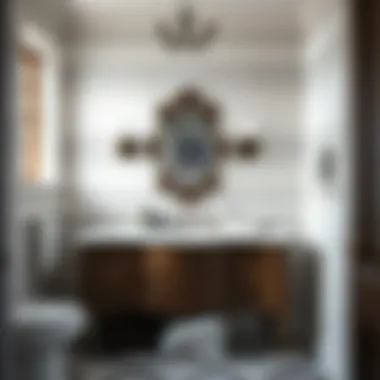
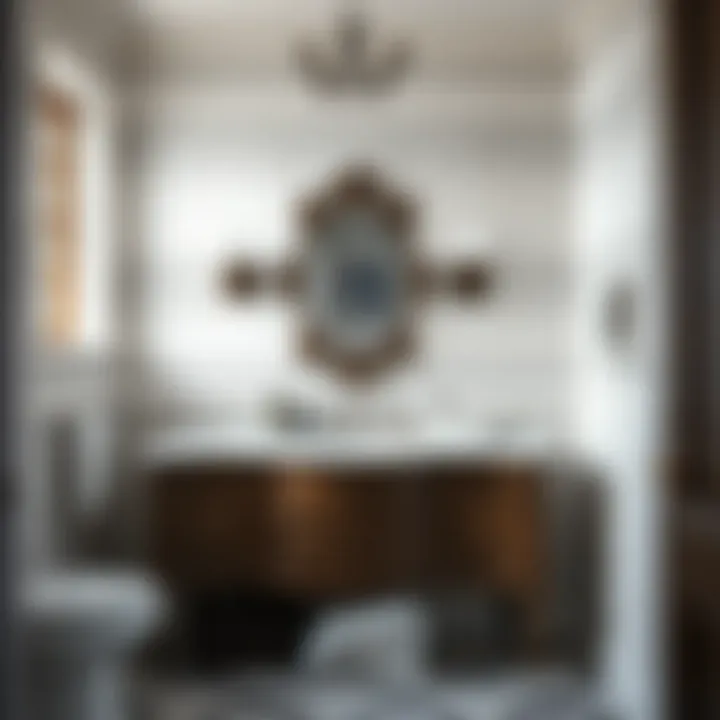
Complementing Existing Decor
One of the foremost aspects of integrating a 36-inch antique bathroom vanity is its ability to complement existing decor styles. Whether your home leans towards vintage charm or modern minimalism, a well-chosen vanity can bridge the gap between eras.
When you select a vanity, consider its finish and the materials used. For example, a dark mahogany vanity may blend beautifully with a traditional, rustic decor, while a lighter oak can brighten up more contemporary or Scandinavian aesthetics. It’s key to identify the overarching color palette of your bathroom. Think of harmonious hues or contrasting tones that enhance the overall visual appeal. Additionally, you might think about the hardware—vintage knobs and pulls can amplify the antique feel, tying everything together beautifully.
To illustrate this, suppose you have a bathroom featuring soft gray tiles and porcelain fixtures. A creamy, distressed antique vanity could serve as a stunning focal point, softening the rigid lines of modern materials while still echoing the classic style.
Enhancing Lighting and Features
Lighting plays a crucial role in highlighting the aesthetic appeal of your antique vanity. The right illumination can transform your bathroom from drab to fab, accentuating the fine craftsmanship and detailing of the vanity. Wall sconces positioned beside or above the mirror can create an inviting glow, not only adding to the ambiance but also ensuring your space feels larger and more open.
Consider using warm light bulbs that mimic natural sunlight; they enhance the richness of wood finishes while creating a cozy atmosphere. Moreover, strategically placed mirrors can amplify light further and create an illusion of depth, making your bathroom feel more expansive.
Additionally, you might take advantage of architectural features. If your vanity is situated near a window, allow natural light to dance across its surface. Curtains or blinds in light fabrics can help control the incoming light, allowing you to adjust the mood as needed. Incorporating elements like potted plants atop the vanity or decorative displays can add life to the space, which coincidingly draws the eye to the vanity.
Elegantly fusing lighting with antique elements not only enhances functionality but elevates the entire aesthetic experience of your bathroom.
Cost Considerations
When it comes to selecting a 36-inch antique bathroom vanity, understanding the costs involved plays a vital role. Not only does this affect your immediate budget, but it also shapes the long-term value of your investment. An antique vanity isn’t merely a piece of furniture; it’s a centerpiece that can transform a bathroom from mundane to magnificent. With that transformation comes a spectrum of costs, ranging from the purchase price to maintenance down the line.
Budgeting for Purchase and Installation
First things first, let's talk about the actual price tag. The outlay for a 36-inch antique vanity can vary widely based on several factors, including the wood type, craftsmanship, and brand reputation. On average, expect a range from a couple of hundred to several thousand dollars. Here’s a breakdown of what you might encounter:
- Materials: Solid woods such as oak or mahogany generally cost more. Plywood or MDF options are usually cheaper but might not hold the same charm.
- Craftsmanship: Authentic antiques or those made by skilled artisans tend to carry a higher cost due to the level of detail and work put into them.
- Installation Costs: Don’t overlook the installation expenses. Hiring a professional can add anywhere from $100 to $500, depending on plumbing changes that might be required. It’s crucial to factor these expenses into your overall budget.
While it’s tempting to go for the cheapest option, it’s significant to weigh the potential benefits of spending a bit more on quality.
Long-term Value and Investment
Purchasing an antique bathroom vanity is not just about today’s costs; think of it as an investment in your home’s future. Over time, the right vanity can significantly enhance your bathroom's appeal, resulting in better resale value. Here’s how to see the bigger picture:
- Durability: Well-crafted antique vanities are made to last. They often outlive modern counterparts if maintained properly, potentially saving you replacement costs down the road.
- Aesthetic Appeal: An attractive vanity can serve as a focal point in your bathroom, increasing overall visual interest. Should you decide to sell your home one day, this can contribute significantly to buyers' perceptions.
- Unique Value: Antique pieces often reflect a craft and history that cannot be replicated. If chosen wisely, these vanities may appreciate over time, making them more than just functional items.
"Investing in quality is investing in longevity. While upfront costs may seem daunting, the value gained over time can be well worth the effort or expense."
Trend Forecast for Antique Vanities
The antique bathroom vanity is a significant piece in home design, especially as homeowners look to blend classic elegance with modern functionality. With many people aiming for a personal touch in their bathrooms, knowing the trends can make a world of difference. This section dives into the emerging styles and sustainability aspects related to 36-inch antique vanities, aiming to inform and inspire those seeking to enhance their spaces.
Emerging Styles and Designs
When discussing the current trends in antique bathroom vanities, it’s important to note how styles are evolving. A growing preference is seen towards blended designs that marry traditional elements with a modern flair. For instance, you might find pieces that retain the traditional woodwork but incorporate sleek lines or innovative storage solutions for practicality.
- Mixed Materials: More consumers are open to combining different materials like wood and metal, introducing industrial touches alongside the timeless charm of wood. Metal drawer pulls on a distressed oak finish can strike the right balance between vintage and contemporary.
- Bold Colors: Traditional dark wood finishes are still popular, but expect to see brighter hues like deep greens or bold blues gaining traction. These colors can add vibrancy to neutral bathrooms and draw the eye.
- Minimalist Antique: Some designs are shifting towards minimalism, where the antique charm remains, but excess embellishments are reduced. Think clean lines with a slight vintage touch, resulting in a sophisticated yet understated look.
"The antique vanity doesn't need to be confined to traditional norms. Innovation in design allows for freedom of expression and personal taste in every corner of the home."
Sustainability and Eco-Friendly Options
As sustainable design becomes more imperative in modern home renovation, antique vanities fit neatly into this trend. Here are some aspects where environmental consciousness intersects with your vanity choice:
- Reclaimed Materials: Using reclaimed wood not only breathes new life into old materials but also reduces the need for new lumber, which is better for forests. A 36-inch antique vanity made from salvaged wood can have unique character, often with intriguing stories behind each piece.
- Low-VOC Finishes: Many manufacturers are now focusing on eco-friendly finishes that contain fewer volatile organic compounds. These finishes are better for indoor air quality and contribute to a healthier home environment.
- Longevity: Investing in a quality antique vanity often means fewer replacements over time, which is a sustainable choice. A well-maintained antique piece can last for decades, proving to be not just an aesthetic decision but also a conscious choice aligned with sustainability.
By understanding these trends, homeowners can make informed decisions that align aesthetically with their vision while being mindful of their environmental footprint. The antique bathroom vanity is not just a stylistic statement but also a reflection of an evolving market that values history and sustainability.
Finale and Recommendations
When it comes to choosing furnishings for a bathroom, the 36-inch antique vanity offers a blend of functionality and charm that is hard to overlook. This section wraps up key insights regarding what makes these vanities a worthy addition to any home.
Antique vanities are not merely furniture; they are statements of style that reflect personal taste and history. Understanding their significance can help homeowners appreciate the distinct aesthetics they bring, making them more than just functional pieces. The 36-inch size strikes a wonderful balance, catering to both compact and spacious bathrooms. In considering these vanities for your own space, one should weigh both stylistic preferences and practical functionality.
Summarizing Key Points
- Historical Significance: Antique vanities often come with stories and craftsmanship that modern pieces may lack. This history can significantly enrich the ambiance of your bathroom, adding character.
- Size Matters: The 36-inch width is ideal for maximizing space without overwhelming smaller bathrooms. It effectively combines a handsome appearance with practical use.
- Material Variety: From solid wood to ornate hardware details, the materials used in these vanities not only enhance visual appeal but also longevity if cared for properly.
- Customization Potential: Many antique vanities can be tailored to fit individual needs, whether it’s altering the finish or adding personalized hardware. This degree of customization allows for a truly unique piece in your home.
- Integration with Modern Design: These vanities can seamlessly blend into various design aesthetics—from rustic charm to sleek modernity—making them versatile choices for any makeover.
These points highlight the multi-faceted benefits of incorporating a 36-inch antique bathroom vanity into your home.
Choosing the Right Vanity for Your Space
Selecting the perfect 36-inch antique vanity is more than just picking a pretty face. It involves considering a variety of factors that cater to both aesthetic desires and practical needs. Here are some aspects to keep in mind:
- Style Compatibility: Ensure the vanity matches your existing decor. For example, a Victorian-style vanity might clash with a more minimalistic modern bathroom.
- Storage Needs: Think about what you need to store. Some vanities come with ample drawer space while others might feature open shelving. Assess your storage requirements before making the final decision.
- Countertop Material: The surface of the vanity is just as vital. Do you prefer marble, granite, or perhaps something more rustic like reclaimed wood? Each material has its own maintenance considerations.
- Plumbing Configuration: It's useful to consider where the plumbing is situated. Some antique vanities come with pre-drilled holes for sinks and faucets, so ensure compatibility with your existing setup.
- Antique Condition: If buying vintage, inspect the condition thoroughly. Look for signs of wear or damage, and consider how much restoration might be needed.
- Consider pairing dark woods with muted colors if aiming for an old-world charm.
- Identify what items you plan to keep handy and choose a design that accommodates these.
- Remember that some materials may require sealing for longevity.
- Sometimes a little TLC can bring an old piece back to life, but be realistic about your willingness to put in the work.
By considering these aspects carefully, you can find a 36-inch antique bathroom vanity that not only enhances your space but also meets your practical needs.













